The Senseless Shift
Alanna Thain
night-spell, n.
A spell intended as protection against harm at night.
A spell intended to cause harm or trouble at night. Now rare.
Two Birds
Even in Middle English, “birds” had that slangy, dismissive sense of girls, familiar from the swinging 60s. In the medieval poem “The Owl and the Nightingale,” two birds go at each other in a debate around nocturnal vices, sex before marriage, labour, sloth and good looks. This poem is one source for tracking the enchanted temporality of the word spell as a “period or space of time of indefinite length,” when one bird says to the other Lat Pine tunge habbe spale!: essentially, shut up!1 Birds talking, especially to each other, is always at risk of tipping into something sinister or frivolous, enchantment or gossip. Translating this spell, Ian Gordon tracks a curious etymology that binds rest from labour to the labour of the double or the substitute, within an amorphous stretch of time: “The development of meaning would appear to be (a) O.E. spala ‘a substitute’; (b) spale, spell ‘period of rest spent as a substitute’; (c) period of rest during relief by a substitute; (d) period of rest—from labour, grief, annoyance, etc. (the idea of a substitute disappearing).”2 Spell is a strange dance of stepping in and stepping out of work’s neat boundaries, tracing how labour is a drag blurring the edges of the somatic self. Although spell as enchantment or magical words is etymologically parallel to the chiasmus of spell as rest or relief, the latter’s strange exchange between doubles and rest is haunted by an otherworldly sense. This is clear in the feminist search for restorative sleep. Between an ambiguous “off time” from labour (an interval or period of repose or relaxation; a rest) and the relay of labour exchange (to give a spell, to relieve another by taking a turn of work) is the embodied knowledge of so many women and femmes, that sleep has never been a simple site of rest for an integral self. Sleep could be seen as a variation of the feminine socially reproductive labour—the work of cleaning, cooking, caring, fucking and more— identified by 1970s Marxist feminists as often unwaged, unvalued and essential to the functioning of capitalism. If housework could be named as the second shift of feminized labour, today sleep is coming into view as a senseless shift of dispossessive labour.

Lucy (Emily Browning) lies down on the job in Sleeping Beauty. Julia Leigh, director. IFC Films, 2012.
The last decade has seen a wave of feminist media where sleep’s thresholds are weaponized both by and against feminine bodies at risk. There are so many recent works by women around disenchanted rest, performance anxiety and labour that we might have a new body genre: the feminist sleep thriller. Works like Sleeping Beauty (Julia Leigh, 2011), Promising Young Woman (Emerald Fennell, 2020), and I May Destroy You (Michaela Coel, 2020) take sleep as a site of feminist disenchantments. Critically interrogating the supposed passivity of the Sleeping Beauty myth, they take up and stretch out horror affects, mobilizing the affordances of sleep to access a kind of everyday risk that I call the labour of being a body. Such works exploit the rest/relief indistinction, weaponizing the soft spaces of sleep’s vulnerability against the recent mainstreaming of its capture in biometric tracking and ostensible novelty of the always-working of late capitalism.

Cassie (Carey Mulligan) can’t sleep in Emerald Fennell’s Promising Young Woman. Emerald Fennell, director. Focus Features, 2020.
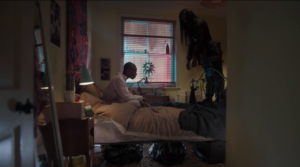
Arabella (Michaela Coel) can’t sleep in I May Destroy You. Michaela Coel, producer. BBC 1 and HBO, 2020.
These works complicate the contemporary idea that what Matthew Wolf-Meyer terms “somnolent capitalism” encroaches upon a previous sacrosanct sleep, where off-hours labour was the exception rather than the norm.3 Jonathan Crary has dubbed this our 24/7 condition, breaching sleep as a final frontier against extractive capitalism.4 The 1950s marked a moment that shifted the popular North American understanding of sleep away from seeing sleep as an inert counterbalance to conscious activity and waking life—a necessary or necessary evil counterpart to the good life of productive labour rooted in white American puritanical histories—to an active state. Eugene Aserinksy, experimenting on his eight year old kid as a research subject, first documented brain activity in sleeping subjects in 1951: REM or so-called “paradoxical” sleep as a site of brain activity.5 Interest in sleep’s agentic activity has only intensified since the development of sleep medicine in the 1970s, individualizing the responsibility for good sleep, a new wave of sleep pharmaceuticals in the 1990s, including what would become the new wave of “date rape” drugs, and the new extractive and quantifying attitude towards sleep resulting from biometrics, tracking, modulation and datafication of sleep as commodity. Sleep thus has a nuanced relationship to “agency” as it has become more “actionable” as a measurable and modifiable zone.
In their complex exchanges around labour, feminist sleep media often mobilize the horror affects of somnolence, enervating the sharp edges of more conventional horror thrills, and the distinction between normalcy and deviance. In doing do, they expose the everyday labour—and horror—of being a body marked female and raise difficult questions of creepy agency, dispossession and vulnerability. Sleep is a space of work, the site of the relentless extraction of the body’s capacities and biopolitical management, through monitoring and modulation, where the labour of being a body itself is intensified. Rather than naming a novel state of affairs, an encroachment on virgin territory, feminist, queer, and racialized sleep horror understands this state not as a break in the fabric of reality that allows a horrific otherworldliness to emerge, but as the enervating conditions of everyday life. When should be a spell from labour is often just the place where a body, not entirely your own, steps in to play act in your stead. Feminist sleep horror thus has a dual affective charge of registering shock, fear and terror, but in the key of exhaustion. In these works, risk circulates across respite and replacement as one way of registering 24/7 labour, a recirculation that, like sleep, complicates the threshold between life and death. “Enspelled” sleep serves to modulate horror’s intensities, creating affective short circuits and amplifying sleep’s warped temporality.
Dread, in this current wave of sleep horror media, marks how a waking/dreaming binary is displaced by the grey zone of somatic capitalism, where even off-hours are occupied by apps that track, quantify and assess us while we sleep, for purposes not our own. But just as “affective labour” as a characterization of post-Fordist labour is amnesiac about its similarity to socially reproductive labour, the novelty of datafied and extractive sleep as a site of self-monitoring obscures its echoes in practices of feminine self-surveillance and objectification. This dispossessive horror is amplified by sleep’s specific vulnerabilities. Our lack of conscious access to the experience of sleep impacts the credibility of our own somatic experience—what we might call the feminist complaint—when it comes to reporting sleep disturbances that menace the health of mind and body. The sleeping self is an unreliable witness, even more so when marked by a feminine difference. In sleep, we become our own intimate stranger: our autonomy is dispossessed and redistributed. While this puts us at risk, it is not just safety that is worth seeking. Feminist sleep horror asks how rest and relief might co-exist, such that our radically vulnerable and somnolent labour might be spelled by social forms of care and collective concern for sleep’s tender threshold.

Laura Palmer’s (Sheryl Lee) bedroom in Twin Peaks: Fire Walk With Me. The soft, dim lighting doubles everything with a shadow, blurring the image. David Lynch, director. New Line Cinema, 1992.
The sleeping body—a site of feminist agency, action and work—brings into view spell’s curious relation to the double and the feminist senseless shift of sleepwork. A film like Fennell’s Promising Young Woman, a rape-revenge sleep thriller where a young woman fakes sleep to lull would-be rapists on dates and at the club into a very false sense of security, wears its debt to Twin Peaks (David Lynch, 1990-91, 1992, 2017-18) on its sleeve and to the character of Laura Palmer (Sheryl Lee) as Sleeping Beauty. Palmer has been seen as launching a contemporary televisual version of what Alice Bolin calls the “dead girl” trope.6 But there was rarely such an unruly corpse, and from the moments the murdered teenager drifts into view, interrupting Pete’s (Jack Nance) leisurely rejection of work (“gone fishing”), she becomes the flashpoint of the impossible and unliveable exchange between the double and rest, mediated by sleep as the opaque threshold between waking life and death. In the first TV series, Palmer is relentlessly reanimated after her murder through her constant recirculation through media and as image: cassette tapes of her therapy sessions, her multiple diaries, a home movie, her photograph. These substitutes continually step in, spelling Palmer as the hardest working body in town. In life, this teenager was a sex worker, a low-waged salesgirl at a perfume counter, a tutor, Meals on Wheels delivery woman, homecoming queen, a student trying to get through high school. Palmer is repeatedly characterized always characterized as living a “double life.” But beyond this binary, she is simply always on the clock; her jolting affective shifts are all part of the labour of being a body.
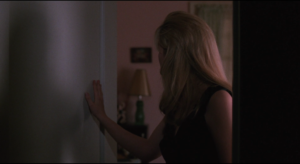
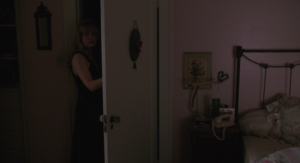
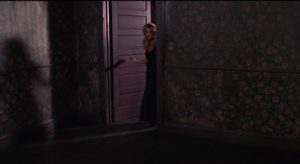 No exit: enspelled thresholds of sleep and dreams in Twin Peaks: Fire Walk With Me.
No exit: enspelled thresholds of sleep and dreams in Twin Peaks: Fire Walk With Me.
And it is only in the film that recounts her final days, Twin Peaks: Fire Walk With Me, that the fatal spell of the stand-in for rest becomes clear. Laura is given a picture of a doorway while doing volunteer work. She hangs it in her bedroom the night she begins to investigate who has been raping her in the night. When she falls asleep, she walks through the door in the picture, entering a dream world full of symbolic and prescient encounters. When she wakes, she gets out of bed and looks into the hallway, but looking back over her shoulder, sees herself in the doorway in the picture, doubling her every move. Her bedroom is no refuge but a crossroads where the senseless shift of dreamwork, sex work and the relentless labour of being Laura Palmer carries on. Laura Stewart, discussing Palmer’s impact in the book Laura’s Ghost, describes how many women saw in Palmer their own double: “There’s always going to be those jokes about ‘How did Laura find the time to do ten jobs while she was in school and doing Meals on Wheels and while she was sleeping with half the town?’ But now lots of women speak up and say, ‘Well, no, actually I behaved like that, because the same thing happened to me.’”7 Laura Palmer enchants everyone around her but is also subject to possession beyond her control. In poet Anne Sexton’s version of the story of Briar Rose, the sleeping beauty is an abused, insomniac daughter, “my father thick upon me/ like some sleeping jellyfish” who sleeps only when she drugs herself senseless: “She married the prince/ and all went well/except for the fear -/the fear of sleep.”8 Dispossessed of rest, she can never know her sleeping self, who spells her to offer respite from the memory of violation. Laura, in a different moment, tries to weaponize her own sleep, in the gap between substitute and respite, to coincide with her sleeping self. Though she doesn’t survive, the effect of her disenchanted sleep is a wild proliferation of doubles through the world of Twin Peaks, a relentless restlessness. The double figures the dispossession of sleep; while all doubles are enchanted figures, they also trouble the off-hours of the labour of being a body.
Tongues Unspelled
As with Twin Peaks, the new wave of feminist sleep horror project is inextricable from the horror of sexual violence. This is nothing new. What does seem new is the way that this is connected to labour and consent, both as a result of movements like #metoo and #timesup, and also from the feminist skepticism towards the “novelty” of late capitalist 24/7 labour. Director Anna Biller, best known for her 2016 feature The Love Witch, tweeted this question on Jan. 3, 2021: “Are there any rape-revenge movies where the protagonist has a fully fleshed out character aside from her rage and violence?” Feminist sleep horror media’s use of sleep to articulate something specific about labour is a novel twist on genre and in particular horror’s connection to rape revenge films. In her essay “Riot Horror: Rape-Revenge and Reproductive Labor in American Mary,” Johanna Issacon situates the Soska sisters’ 2012 film American Mary in “the era of feminized labor,” where feminist makers are “reshaping the horror genre around this era’s key concerns.”9 Mary, a young and poor medical student is drugged and assaulted by her professors. She drops out of med school (just like the character of Cassie in Fennell’s Promising Young Woman) and fashions a parallel career for herself in body modification, ultimately kidnapping and violating her rapist in turn. Isaacson claims that
today, work performed by all genders resembles the historical conditions of so-called “women’s work”—low or no wages; no union, contract, or state protection; precarious, affectively demanding, and often in either the service or the reproductive sector. These changes in labor have, in turn, produced thematic shifts in the contemporary horror film. Contemporary horror film insists that feminized reproductive work is not ancillary but central to contemporary capitalism, and that immiseration and exploitation must be understood through this expanded account of contemporary labor.10
Three weeks after Anna Biller posted her question about rape-revenge films, later she tweeted this:

Biller’s own rape-revenge film, unlike the more graphic horror of American Mary, is set in the key of exhaustion and reverie. Though a throwback in terms of style and setting, A Visit From the Incubus frames labour within the off hours of sleep, and in terms of the relentless capture and creative modulation of 24/7 labour. The tagline for American Mary is “she’s an artist”; this conflation of creativity and labour through women’s work is found in Biller’s film and the figure of the actress as a double, understood as a labour without respite. Sleep becomes the stage for different kinds of encounter, where horror affects rework the everyday risk of being a body through spells of rest and relief.
In the opening scene of Biller’s 2006 Western-musical-horror short, A Visit from the Incubus, two birds get together to gossip over coffee and bread in a parlour in a frontier town. An exhausted Lucy (Anna Biller) confides in her friend Madeleine (Natalia Schroeder) that she is being visited every night by a repulsive figure: an incubus. The film’s title cards do a lot of narrative heavy lifting: “An incubus is a horrible demon who has sexual intercourse with sleeping women. The woman is unable to wake, but has a NIGHTMARE. The incubus has oppressed women for centuries and continues to be a problem today. Our story takes place in the Old West.” Over the title credits this legend is elaborated in a warbling and descriptive ballad, outlining the incubus’ habits of visiting at night and warning women to lock their windows. “He does his job/ then leaves ugly blight/ the incubus, the outlaw of the night.” Assault is masculine labour and outside the law—as Lucy points out, “the police can’t help.” Sung by a man, at the end of the chorus, a woman’s voice wordlessly echoes the tune in senseless affirmation.
Lucy’s name calls to mind one of fiction’s night birds, Lucy Westenra, who suffers a long period of sleep walking and unrestorative rest while Dracula feeds on her blood in the night in Bram Stoker’s 1897 novel Dracula. After Lucy converts to a vampire, she is murdered by her male suitors so that she can finally “rest in peace.” In Biller’s film, Lucy’s friend Madeleine, full of sympathy, has her own confession to make: she too has been visited by the incubus. Though, he’s not quite a vampire, she points out, desiring “not blood” but “that which a wife should only bestow on her husband.” Lucy gives her friend a little side-eye at this gloss; she spends the film wrestling with what it would mean to be self-possessed.

Madeleine (Natalia Schroeder) and Lucy (Anna Biller) with the curtains closed against the day to discuss nighttime matters.
In the sumptuous visuals of Biller’s set and in her costume, Madeleine recalls one of cinema’s most notorious somnambulists: Madeleine Elster (Kim Novak) in Alfred Hitchcock’s Vertigo, garbed and lit in green. A somnolent zombie intermittently possessed by the spirit of her ancestor, Madeleine sleepwalks her way all over San Francisco and then finally into Scottie’s (Jimmy Stewart) bed. When she throws herself in a (fake) trance into San Francisco Bay, Scottie rescues her and takes her to his place. She wakes up in his bed, naked and wary, “wondering” how she got there, setting Scottie up in his role as a chaste Prince Charming bewitched by what he wants to see.

Actually, Madeleine is not an insomniac or a troubled sleeper, she just plays one in someone else’s dream. Her somnambulist derives are fatally enchanting to Scottie but ultimately to her as well, as no one wants her in her waking life. One of cinema’s great doubles, Madeleine turns out to be a substitute, a stand in for the corpse to be of the real Mrs. Elster, played by her husband’s mistress, Judy. Across the relay of substitutes standing in for the labour of being a body, Madeleine/ Judy is dispossessed of her labour in the endless swap of doubles. Judy as Madeleine works for love, not money, and pays with her life. Vertigo is a film where a woman is asked to playact as Sleeping Beauty, but such ‘spelling in’ is still real and deadly work. Even Kim Novak was accused of being a poor actress, failing to adequately demarcate the difference of Madeleine and Judy so we can tell when one body spells another. Madeleine is a stand-in at every turn; to keep Scottie enspelled within the dream logic, she stays trapped in the nightmare where she can never call to account her own labour. In Biller’s film, Madeline is decked out in Vertigo’s ghostly green, and she struggles to find her way out of a nightmare hemmed in on all sides by the exchanges between men, where the only respite for her troubled sleep would be the on-the-books labour of the marriage bed.

Vertigo’s Dream Girl (Kim Novak).
While grateful for the snacks and sympathy, Lucy is unsatisfied by Madeleine’s accounting and unconvinced her friend can help her. Madeleine’s vertiginous echoes for Lucy are a warning. The first thing she does when she leaves that house is buy herself a new dress.

That night, the incubus comes again, as dumpy and repulsive as Lucy has described. Biller viscerally conveys this tedious violation through a long sequence of the incubus hovering over Lucy’s sleeping form, luridly and grotesquely smacking his lips, with his devil horns perched on a receding hairline. Lucy wakes to find his grotesque green cum stain on her nightgown. “Depressed and mighty sore,” she takes a long look at herself in the mirror, and, liking what she sees, she decides to go into town and get a job as a singer at the local saloon, flashing some leg at the owner to seal the deal. That night she ends up on a double bill with none other than the Incubus himself. Onstage, they battle it out for the currency of spectatorial love. Up first, the incubus gives a Gong Show of a performance, booed off the stage. He simpers around, nasally singing “Oh My Lucy,” a jaunty vaudeville tune that seems idolizing but that keeps creeping into the suggestive: “Oh my Lucy/ she never compromises/ in a compromising situation.” Wink wink. He tries to build a career on the back of her image but almost closes down the joint, totally delusional about his appeal. Lucy, on the other hand, is a huge hit with the cowboys and ranchers, playing to their friendly egos about how you are nothing unless you are a star. She is showered with applause and adoration.
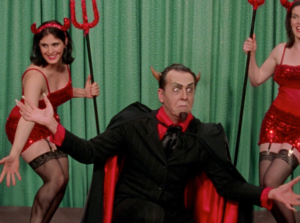
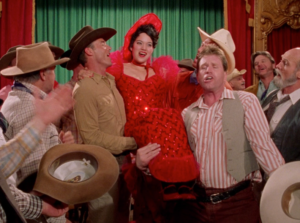 The Incubus (Jared Sanford) bombs, while Lucy (Biller) gets her revenge.
The Incubus (Jared Sanford) bombs, while Lucy (Biller) gets her revenge.
Drinking her whiskey at the bar after her act, the incubus sidles up Lucy to bitterly gripe “I bet you think you’re a big actress now.” “Yes, I’m an actress now,” she replies. Enchanting the audience, she finds the coincidence between rest and relief as her stage persona—her double—spells her as in the labour of being a body. Though the incubus dismisses her as “just an amateur,” the owner immediately approaches her with a professional offer and a five-year contract. She accepts, telling him: “It does a lot for my self-esteem, to feel that I can be accepted by an audience and earn a living at the same time.” The incubus is left unbloodied but socially eviscerated at the bar.
A second body of ambivalent ownership is her feminist reappropriation of rest as relief, under the sign of sleep. Lucy’s curious determination that the best revenge against the incubus is to get paid to perform underscores her insight that sleep is already a site of labour. Revenge is a lateral move, squeezing out the Incubus from her bed and from the stage where he tries to profit off her image as material. When Lucy makes this remark about self-esteem, it is a dignified and vulnerable moment, rather than toweringly triumphant. The incubus dispossessed her of sleep and even her own image and reputation, singing “Oh my Lucy” as if he owns her, conjuring up her image in the thin air of the stage. But Lucy makes dispossession a sociable art: “a star is nothing,” she sings, “without your fans”. She restages the vulnerability of sleep outside of the private bedroom, the legitimacy of marriage, the intimacy of female friendship, and makes the labour of sexual violence sociable. Even so, five years under contract is a long time, unspelled.
Sleep, like feminine labour, is often unmarked. Though Biller’s film is a throwback to an earlier moment of film style and history, its conclusions are a critique of both the long history of exploited rest, and inadequacies of our current state of sleep. Like the ambivalences of rape revenge cinema, where even the most spectacular acts of vengeance do little to shift the social conditions that subtend individual violation and harm, Biller’s film leaves the question of genuine relief hanging. The double bind of spell—stepping out or stepping in—remains a relentless performance of that other sense of spell—labour as an indeterminate stretch of time when seen through the “off hours” of the body. Matthew Wolf-Meyer notes that the “twin basis of contemporary sleep medicine” are that “sleep exists outside external influences, and its disorders are individual.”11 If somnolent capitalism demands a worker responsible for their own rest, Biller’s disenchanted sleep replaces the vulnerabilities of sleep and the labour of being a body marked female explicitly in the frame of being able to earn a living wage. If the second shift names the socially reproductive work women do after the paid hours of wage labour are done, the senseless shift, haunted by the figure of the double, names the boggy time of the labour of being a body, neither fully rest nor relief. Though Lucy seems to pull herself up by the bootstraps to exit sexual terror and vulnerability through labour competition, this horror film is tonally ambivalent about the precariousness of her success and survival, the enervations of sleep and its spell. When the double takes the stage, her song is a haunting refrain: “you are nothing without your fans.”
Alanna Thain is professor of cultural studies, world cinemas and gender, sexuality and feminist studies at McGill University. She directs the Moving Image Research Lab, which explores the body in moving image media broadly conceived, and is former director of the Institute for Gender, Sexuality and Feminist Studies. She runs the research-creation project Cinema Out of the Box, a bike powered itinerant outdoor cinema. She leads the FRQSC funded research team CORÉRISC (Epistemologies of Embodied Risk), focused in its first iteration on queer, feminist and minoritarian horror in media, art and performance. Her book, Bodies in Suspense: Time and Affect in Cinema, looks at how unusual or aberrant experiences of time resensitizes us to our own corporeal volitility around the body’s primary capacity: change over time or “anotherness”. She co-directs the NFRF funded project The Sociability of Sleep, which takes a research-creation approach to the equities and affordances of sleep, and through that project is writing a book on 21st century feminist sleep horror. She is also finishing a book on post-digital screendance as a score for survival, entitled “Anarchival Outbursts”.
Atkins, J. W. H Atkins and Nicholas de Guildford, The Owl and the Nightingale (Cambridge, England: University Press, 1922).
Ian A. Gordon, “The Owl and the Nightingale 258 the Semantic Development of Spell = (‘Rest’).” Modern Language Notes 70, no. 1 (1955): 5–8, 8.
Matthew J. Wolf-Meyer, The Slumbering Masses: Sleep, Medicine, and Modern American Life (Minneapolis, Minnesota: University of Minnesota Press, 2012), 16.
Crary, Jonathan. 24/7: Late Capitalism and the Ends of Sleep (London: Verso, 2013).
Kenton Kroker, The Sleep of Others and the Transformations of Sleep Research (Toronto: University of Toronto Press, 2007).
Alice Bolin, Dead Girls: Essays on Surviving an American Obsession, first edition (New York, NY: Harper Collins Publishers, 2018).
Courtenay Stallings and Sheryl Lee, Laura’s Ghost : Women Speak About Twin Peaks (Columbus, Ohio: Fayetteville Mafia Press, 2020), 202.
Anne Sexton and Barbara Swan, Transformations: Poems (New York, NY: Open Road Integrated Media, 2016) 110, 108.
Johanna Isaacson, “Riot Horror: Rape-Revenge and Reproductive Labor in American Mary,” Theory & Event 22, no. 2 (2019): 436–50.
Isaacson, “Riot Horror,” 435-36.
Wolf-Meyer, The Slumbering Masses, 37.